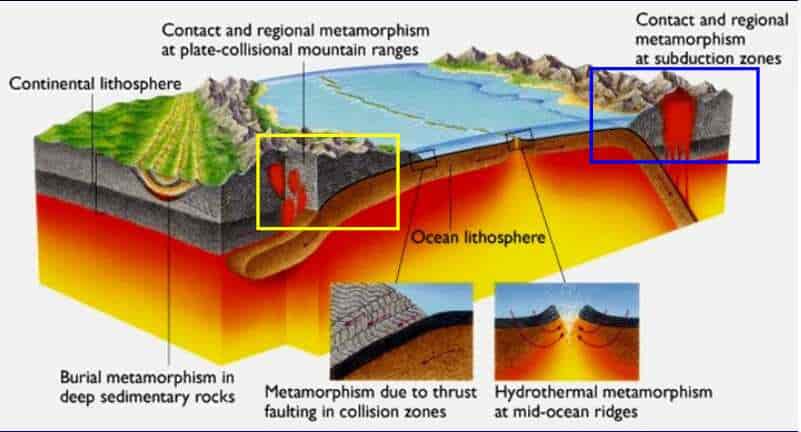
Week 1. Introduction to Metamorphism
Introduction:
Alteration of the composition or structure of a rock by heat, pressure, or other natural agency. "All the rocks were subjected to several phases of metamorphism and deformation"
Metamorphism is the change of minerals or geologic texture (distinct arrangement of minerals) in pre-existing rocks (protoliths), without the protolith melting into liquid magma (a solid-state change). The change occurs primarily due to heat, pressure, and the introduction of chemically active fluids. The chemical components and crystal structures of the minerals making up the rock may change even though the rock remains a solid. Changes at or just beneath Earth's surface due to weathering or diagenesis are not classified as metamorphism. Metamorphism typically occurs between diagenesis (maximum 200°C), and melting (~850°C).
Moreover, Metamorphism, mineralogical and structural adjustments of solid rocks to physical and chemical conditions differing from those under which the rocks originally formed. Changes produced by surface conditions such as compaction are usually excluded. The most important agents of metamorphism include temperature, pressure, and fluids. Equally as significant are changes in chemical environment that result in two metamorphic processes:
(1) Mechanical dislocation where a rock is deformed, especially as a consequence of differential stress;
(2) Chemical recrystallization where a mineral assemblage becomes out of equilibrium due to temperature and pressure changes and a new mineral assemblage forms.
The geologists who study metamorphism are known as "metamorphic petrologists".
To determine the processes underlying metamorphism, they rely heavily on statistical mechanics and experimental petrology.
Three most common types of metamorphism exist: contact, dynamic, and regional. Metamorphism produced with increasing pressure and temperature conditions is known as prograde metamorphism. Conversely, decreasing temperatures and pressure characterize retrograde metamorphism.
Metamorphic rocks can change without melting. Heat causes atomic bonds to break, and the atoms move and form new bonds with other atoms, creating new minerals with different chemical components or crystalline structures (neocrystallization), or enabling recrystallization. When pressure is applied, somewhat flattened grains that orient in the same direction have a more stable configuration.
For detail, download pdf and ppt.



